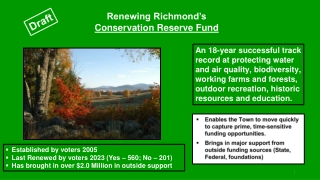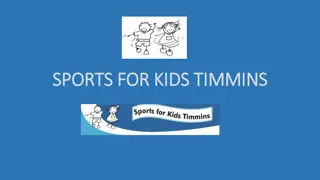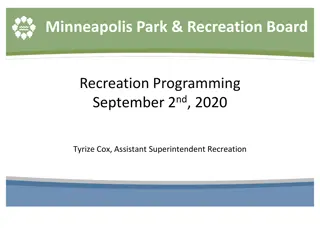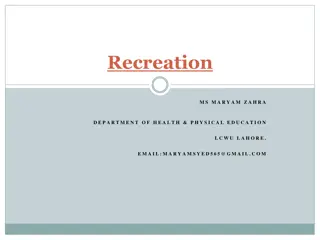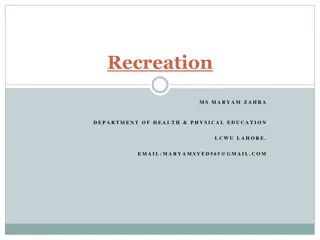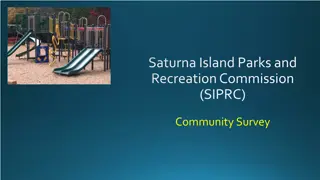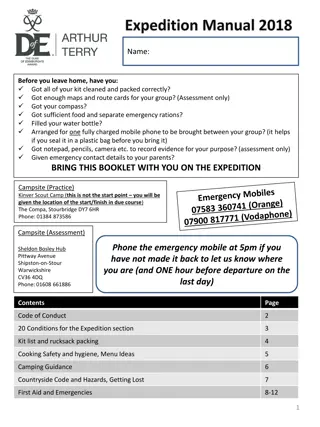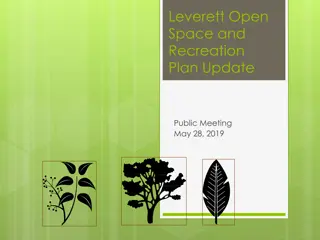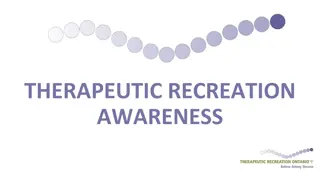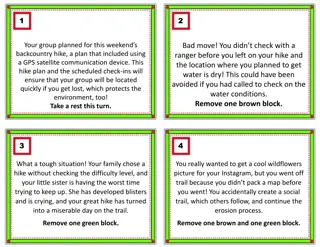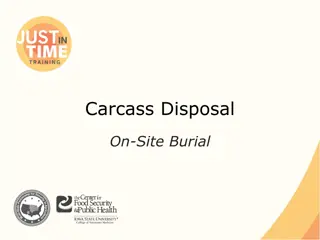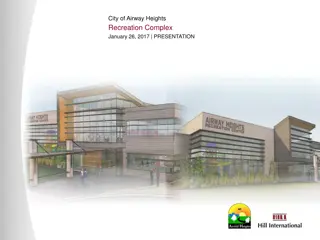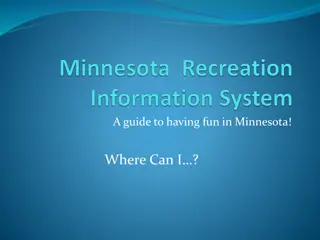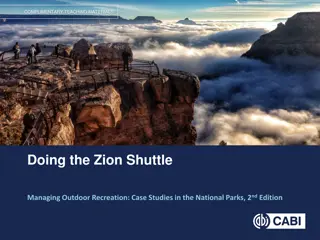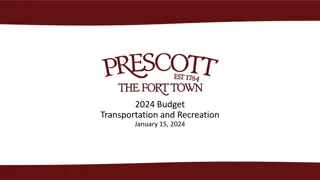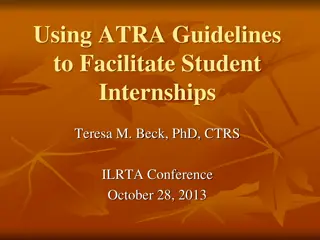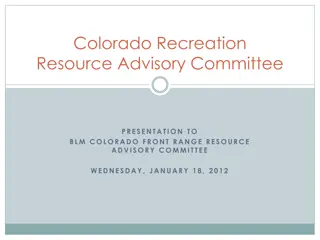Effective Campsite and Recreation Site Management Strategies
Explore comprehensive strategies for designing, constructing, and managing campsites and recreation areas to minimize environmental impacts and enhance visitor experiences. Learn about selecting resistant sites, implementing construction techniques, and sustainable management practices for outdoor recreational facilities.
Download Presentation

Please find below an Image/Link to download the presentation.
The content on the website is provided AS IS for your information and personal use only. It may not be sold, licensed, or shared on other websites without obtaining consent from the author.If you encounter any issues during the download, it is possible that the publisher has removed the file from their server.
You are allowed to download the files provided on this website for personal or commercial use, subject to the condition that they are used lawfully. All files are the property of their respective owners.
The content on the website is provided AS IS for your information and personal use only. It may not be sold, licensed, or shared on other websites without obtaining consent from the author.
E N D
Presentation Transcript
Campsite & Recreation Site Management Jeff Marion, Unit Leader/Scientist Virginia Tech Field Unit, USGS, Patuxent WRC jmarion@vt.edu, 540-231-6603
Presentation Objectives 1. Describe campsite/recreation site design and construction strategies, including: Select resistant sites Construct resistant sites Provide facilities that reduce impacts 2. Describe campsite/recreation management strategies, including: Maintain sites to contain impacts Manage visitors to reduce impacts 3. Review alternative camping management strategies.
Select Resistant Sites Rock Sand/gravel Grasses Organic litter
Select Resistant Sites Select campsites that resist expansion due to: Topography Rockiness Dense Vegetation
Construct Resistant Sites Use site engineering to contain site expansion: Cut and fill work on slopes Create raised tent pads Place fill in rocky terrain
Campsite Construction Flat Terrain Campsite Signpost Ice-berg Rocks
Campsite Construction Sloping Terrain Excavation Stone Cribbing Fill Side-hill Campsites 10 x 12 Campsite w/3 tent pads
Side-hill Campsites
Backcountry Campgrounds Creek Appalachian Trail Side-hill campsites in sloping terrain with individual tentpads Shelter Toilet Bear Bag Cable Separated from the shelter and each other with individual access trails to promote solitude Sign orienting visitors to the camping area Trail layout avoids creation of additional water access trails Shelter Access Trail Tent sites Variable number of tent sites for different group sizes
Provide Facilities That Reduce Impacts Campfire Rings Toilets Shelters
Provide Facilities That Reduce Impact Stock Hitching Facilities Tent Platform Picnic Tables
Maintain Sites To Contain Impacts Improve Tent Pad Sites Reinforce Eroding Spots Restore Unnecessary Areas
Maintain Sites To Contain Impacts Create Site Borders: Rocks Embedded Logs
Manage Visitors to Reduce Impacts Promote Leave No Trace Practices Establish Regulations
Leave No Trace (LNT) Outdoor Skills and Ethics A National Education Program Designed to Teach Stewardship, Land Ethics, and Outdoor Skills For more information: 1-800-332-4100 or www.LNT.org
Promote Leave No Trace Practices Use Established Sites in High-Use Areas Concentrate activities within disturbed areas Use Pristine Sites in Remote Areas Disperse activities Avoid permanent disturbance
Establish Regulations Prohibit Axes, Saws, or Campfires Designate Campsites Require Permits or Reservations
Establish Regulations Regulating Groups: Restrict Groups to Group Sites Require Reservations for Groups Limit Group Sizes
Campsite Impact Management Strategies Dispersal vs. Containment Containment (Concentration) Total Change (%) Dispersal Nights/Year (#)
Rationale for Dispersal & Containment Strategies Use/Impact Relationship . . b a Unregulated Camping Total Change (%) 1 campsite 45 nights/yr Impact is minimized by closing two campsites and tripling use on the third. Impact increases on third site from a to b but aggregate impact is reduced from (3 x a) to (1 x b). 45 . 45 sites, each w/1 night/yr . 15 . 3 campsites each w/15 nights/yr Nights/Year (#)
Camping Management Strategies Four Standard Strategies: Area Closure to Camping At-Large (Unregulated) Camping Dispersed Camping Established/Designated Site Camping (Containment)
Camping Management Strategies Area Closure to Camping Visitors are restricted from camping in sensitive resource areas or in areas that are too close to developed areas, trails, water resources, or attraction features. Site Closure Area Closure Backcountry Closure
Closures Cultural sites Sensitive wildlife habitats R,T&E species
Camping Management Strategies At-Large (Unregulated) Camping Camping is unregulated: visitors may camp in any location they choose. Advantages: Maximizes visitor freedom in site selection. Disadvantages: Jeopardizes visitor solitude and resource protection at higher use levels. Open to camping Closed to camping
At-Large (Unregulated) Camping Problems: Poor site selection Social - too close to other sites Resource - fragile rather than resistant Campsite expansion Campsite proliferation
Camping Management Strategies Dispersed Camping Visitors are instructed to camp on the most resistant surfaces available that show no obvious signs of previous camping use. Dispersal from popular areas may also be promoted to reduce problems with crowding or conflicts. Total Dispersal Point Dispersal Lineal Dispersal
Camping Management Strategies Dispersed Camping Advantages: Provides greater visitor freedom in site selection and promotes solitude. When successful, avoids impact by dispersing use to a level that prevents formation of permanent campsites. Disadvantages: Visitors tend to resist dispersing very far. Considerable off-trail searching may be necessary to locate an appropriate site. Selecting, using, and renaturalizing a pristine site requires greater knowledge and effort.
Camping Management Strategies Dispersed Camping Why Resource Dispersal Is Often Ineffective: Park Environment - Limited flat land or resistant surfaces. Park Management - Restrictions on camping close to trails or water resources may prevent use of the most available flat land. Visitors not instructed to use only pristine sites or Leave No Trace camping practices. Insufficient visitor education. Park Visitors - Visitors may not want to disperse far from trails, water, or other groups. Visitors may lack or fail to apply LNT knowledge.
Camping Management Strategies Camping Containment Visitors are encouraged or required to camp on existing sites or within designated areas. Sites or areas may be selected for their environmental resistance and/or to promote visitor solitude. Designated Areas Existing Sites
Camping Management Strategies Camping Containment Options: Established Sites - Visitors are required to use existing established campsites. Managers close and rehabilitate sites that fail to meet minimum criteria for environmental resistance and/or distance to trails, water, other sites, etc. Advantages: Retains some visitor freedom in site selection and ensures solitude. Minimizes area of disturbance and aggregate impact more than an at-large camping strategy. Disadvantages: Permits more sites and greater impact than under designated site camping. Visitors may create new sites or camp on closed sites.
Camping Management Strategies Camping Containment Options: Designated Sites - Visitors are required to use only designated campsites. The minimum number of sites needed for a specified level of overnight visitation are selected, based on their environmental resistance and solitude potential. Sites that fail to meet criteria or are unnecessary are closed to use. Advantages: Minimizes resource impacts while maximizing visitor solitude. Disadvantages: Restricts freedom in campsite selection, sites will become highly altered.
Camping Management Strategies Multi-Strategy Examples Shenandoah National Park (New) Designated campsites Existing campsites Dispersal and closure within designated areas


